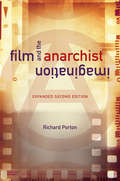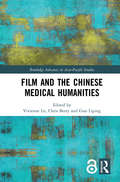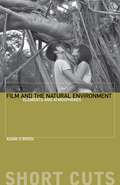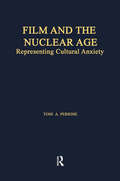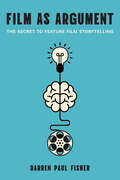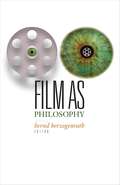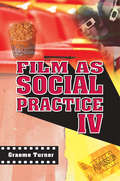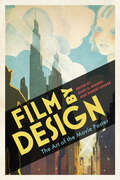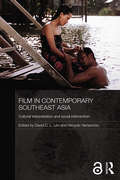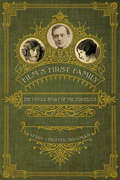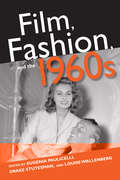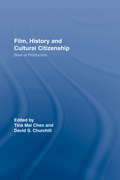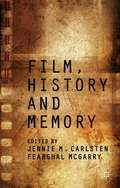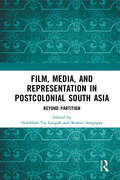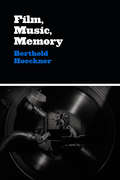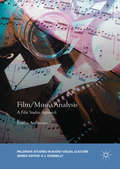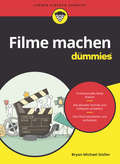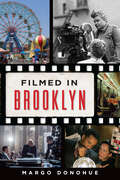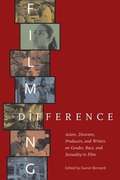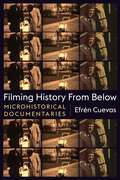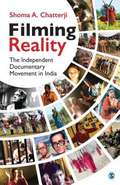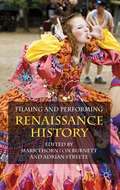- Table View
- List View
Film and the Anarchist Imagination: Expanded Second Edition
by Richard PortonHailed since its initial release, Film and the Anarchist Imagination offers the authoritative account of films featuring anarchist characters and motifs. Richard Porton delves into the many ways filmmakers have portrayed anarchism’s long traditions of labor agitation and revolutionary struggle. While acknowledging cinema’s predilection for ludicrous anarchist stereotypes, he focuses on films that, wittingly or otherwise, reflect or even promote workplace resistance, anarchist pedagogy, self-emancipation, and anti-statist insurrection. Porton ranges from the silent era to the classics Zéro de Conduite and Love and Anarchy to contemporary films like The Nothing Factory while engaging the works of Jean Vigo, Jean-Luc Godard, Lina Wertmüller, Yvonne Rainer, Ken Loach, and others. For this updated second edition, Porton reflects on several new topics, including the negative portrayals of anarchism over the past twenty years and the contemporary embrace of post-anarchism.
Film and the Chinese Medical Humanities (Routledge Advances in Asia-Pacific Studies)
by Chris Berry Vivienne Lo Guo LipingFilm and the Chinese Medical Humanities is the first book to reflect on the power of film in representing medical and health discourse in China in both the past and the present, as well as in shaping its future. Drawing on both feature and documentary films from mainland China, the chapters each engage with the field of medicine through the visual arts. They cover themes such as the history of doctors and their concepts of disease and therapies, understanding the patient experience of illness and death, and establishing empathy and compassion in medical practice, as well as the HIV/AIDs epidemic during the 1980s and 90s and changing attitudes towards disability. Inherently interdisciplinary in nature, the contributors therefore provide different perspectives from the fields of history, psychiatry, film studies, anthropology, linguistics, public health and occupational therapy, as they relate to China and people who identify as Chinese. Their combined approaches are united by a passion for improving the cross-cultural understanding of the body and ultimately healthcare itself. A key resource for educators in the Medical Humanities, this book will be useful to students and scholars of Chinese Studies and Film Studies as well as global health, medical anthropology and medical history.
Film and the Natural Environment: Elements and Atmospheres (Short Cuts)
by Adam O'BrienEnvironmental themes are present in cinema more than ever before. But the relationship between film and the natural world is a long and complex one, not reducible to issues such as climate change and pollution. This volume demonstrates how an awareness of natural features and dynamics can enhance our understanding of three key film-studies topics – narrative, genre, and national cinema. It does so by drawing on examples from a broad historical and geographical spectrum, including Sunrise, A River Called Titas, and Profound Desires of the Gods. The first introductory text on a topic which has long been overlooked in the discipline, Film and the Natural Environment argues that the nonhuman world can be understood not just as a theme but as a creative resource available to all filmmakers. It invites readers to consider some of the particular strengths and weaknesses of cinema as communicator of environmental phenomena, and collates ideas and passages from a range of critics and theorists who have contributed to our understanding of moving images and the natural world.
Film and the Nuclear Age: Representing Cultural Anxiety (Studies in American Popular History and Culture)
by Toni A. PerrineFirst published in 1998. Routledge is an imprint of Taylor & Francis, an informa company. Just as we generally pay scant attention to the potential dangers of nuclear power and nuclear war, until quite recently, scholars have made limited critical attempts to understand the cultural manifestations of the nuclear status quo. Films that feature nuclear issues most often simplify and trivialize the subject. They also convey a sense of the ambivalence and anxiety that pervades cultural responses to our nuclear capability. The production of popular narrative films with nuclear topics largely conforms to periods of heightened nuclear awareness or fear, such as the fear of fallout from nuclear testing manifested in the atomic creatures in science fiction movies of the late 1950s. By their very numbers, and through a set of recurring stylistic and narrative conventions, nuclear films reflect a deep-seated cultural anxiety. This study includes detailed textual analysis of films that depict nuclear issues including the development and use of the first atomic bombs, nuclear testing and the fear of fallout, nuclear power, the Cold War arms race, "loose nukes", and future nuclear war and its aftermath.(Includes bibliographic references, index, filmography, choronology; Illustrated)
Film as Argument: The Secret to Feature Film Storytelling
by Darren Paul FisherIf you’ve picked up this book, it’s most likely that you have an interest in movies over-and-above the typical audience member. Perhaps a screenwriter, producer or director looking to improve your work, always searching for any insight that will result in better cinematic storytelling. If that’s the case, then good news: this is the book for you. It asks a deceptively straightforward question. Why do we make feature films? Is it to entertain? To move and audience? To tell a powerful story? For fame and fortune? You may have answered yes to each, but those answers don’t account for the practice overall. Most books about screenwriting and directing are primarily concerned with craft and technique, but how can you truly understand filmmaking – or make the best films - unless you know what purpose it really serves. So what’s the secret? As the title of this book suggests, making feature films is fundamentally the practice of making a very specific type of argument. To see how this works, we will deep-dive into how filmmakers are trained and taught to think about filmmaking, and what traditions they knowingly or unknowingly follow. We will look at hundreds of films and some major case studies, including Toy Story 3, Schindler’s List, Raiders of the Lost Ark, Amour, and mother!, to explore how and what films argue, and why knowing this can both unlock both a greater appreciation of the form, and improve the impact your films make.
Film as Philosophy
by Bernd HerzogenrathFilm and philosophy have much in common, and books have been written on film and philosophy. But can films be, or do, philosophy? Can they &“think&”? Film as Philosophy is the first book to explore this fascinating question historically, thematically, and methodically.Bringing together leading scholars from universities across the globe, Film as Philosophy presents major new research that leads film studies and philosophy into a productive dialogue. It provides a uniquely sweeping, historical overview of the confluence of film and philosophy for more than a century, considering films from Jean Renoir, Lars von Trier, Jørgen Leth, David Lynch, Michael Haneke, and others; the written works of filmmakers who also theorized on the medium, including Sergei Eisenstein and Jean Epstein; and others who have written on cinema, including Hugo Münsterberg, Béla Balázs, André Bazin, Henri Bergson, Gilles Deleuze, Stanley Cavell, Alain Badiou, Jacques Rancière, and many more. Representing a major step toward establishing a media philosophy that puts the status, role, and function of film into a new perspective, Film as Philosophy removes representational techniques from the center of inquiry, replacing these with the medium&’s ability to &“think.&” Hence it accords film with &“agency,&” and the dialogue between it and philosophy (and even neuroscience) is negotiated anew.Contributors: Nicole Brenez, U of Paris 3–Sorbonne; Elisabeth Bronfen, U of Zurich; Noël Carroll, CUNY; Tom Conley, Harvard U; Angela Dalle Vacche, Georgia Institute of Technology; Gregory Flaxman, U of North Carolina, Chapel Hill; Alex Ling, Western Sydney U; Adrian Martin, Monash U; John Ó Maoilearca, Kingston U, London; Robert Sinnerbrink, Macquarie U, Sydney; Murray Smith, U of Kent, Canterbury; Julia Vassilieva, Monash U, Melbourne; Christophe Wall-Romana, U of Minnesota; and Thomas E. Wartenberg, Mount Holyoke College.
Film as Social Practice
by Graeme TurnerThis fourth edition of our bestselling text has been comprehensively updated and revised to include contemporary film analysis and recent films. With a focus on contemporary popular cinema and examples from Classical Hollywood, Graeme Turner examines the social and cultural aspects of film from audiences and ideologies to exhibition and technology. This fourth edition now includes: new sections dealing with debates about spectacle and special effects an extended treatment of sound and its contribution to cinema film theory’s discussion of the representation of race and ethnicity a thorough update of individual film references a revised applications chapter that includes new contemporary examples new illustrations from contemporary popular cinema. Students of film studies, film practice and film theory will find this a welcome addition to their degree course studies.
Film as a Medium of Seduction: Introduction to the Seduction-Theory of Film
by Marcus StigleggerThe seduction-theory defines film in a broader sense as a medium of seduction, based on the French concept of séduction. It is a theoretical approach influenced by continental philosophy and classical film theory, linked to a three-stage analytical model. The book introduces the theoretical foundations and, using various classical and contemporary examples from film history, presents a genuine method of film analysis.
Film by Design: The Art of the Movie Poster
by Gary D. Rhodes and Robert SingerContributions by Vlad Dima, Laura Hatry, Alicia Kozma, Lynette Kuliyeva, Madhuja Mukherjee, Frank Percaccio, Gary D. Rhodes, Courtney Ruffner Grieneisen, Marlisa Santos, Michael L. Shuman, and Robert Singer Movie posters, regardless of their country of origin, have become indelibly linked with the films they represent, often assuming a status as visual encapsulations of films within collective memory. Long after their initial role in promotion is complete, these posters endure as iconic images, etched into film history and cultural consciousness. One can hardly hear mention of Steven Spielberg’s landmark production Jaws, for example, without immediately picturing the evocative poster art of Roger Kastel.Film by Design: The Art of the Movie Poster is a groundbreaking and comprehensive exploration of the international and Hollywood movie poster as a dynamic artistic and cultural formation. Drawing inspiration from such prominent genres as horror, science fiction, and noir, the twelve essays in this collection provide insightful analyses of the movie poster as a vital component of the cinematic landscape from the silent era to the contemporary period. Crucially, this anthology rejects the notion of movie posters as mere historical artifacts or advertising tools and instead examines them as integral parts of a broader aesthetic framework interwoven into their respective film narratives. Each chapter, whether focusing on controversies, close-ups, or Cuba, is accessible to scholars, students, and fans alike. Through its intervention in film studies, Film by Design reveals the movie poster to be an ever-evolving medium, firmly grounded in both theory and practice, while serving as an essential and enduring element within the realm of film art.
Film in Contemporary Southeast Asia: Cultural Interpretation and Social Intervention (Media, Culture and Social Change in Asia)
by David C. L. Lim Hiroyuki YamamotoThis book discusses contemporary film in all the main countries of Southeast Asia, and the social practices and ideologies which films either represent or oppose. It shows how film acquires signification through cultural interpretation, and how film also serves as a site of contestations between social and political agents seeking to promote, challenge, or erase certain meanings, messages or ideas from public circulation. A unique feature of the book is that it focuses as much on films as it does on the societies from which these films emerge: it considers the reasons for film-makers taking the positions they take; the positions and counter-positions taken; the response of different communities; and the extent to which these interventions are connected to global flows of culture and capital. The wide range of subjects covered include documentaries as political interventions in Singapore; political film-makers’ collectives in the Philippines, and films about prostitution in Cambodia and patriotism in Malaysia, and the Chinese in Indonesia. The book analyses films from Burma, Laos, Cambodia, Vietnam, Thailand, Malaysia, Singapore, Indonesia and the Philippines, across a broad range of productions – such as mainstream and independent features across genres (for example comedy, patriotic, political, historical genres) alongside documentary, classic and diasporic films.
Film's First Family: The Untold Story of the Costellos (Screen Classics)
by Terry Chester ShulmanScandal, adultery, secret marriages, celebrity, divorce, custody battles, suicide attempts, and alcoholism -- the trials and tribulations of the Costellos were as riveting as any Hollywood feature film. Written with unprecedented access to the family's personal documents and artifacts -- and interviews with several family members, including Dolores Barrymore Bedell (the daughter of John Barrymore and Dolores Costello) and Helene's daughter Deirdre -- this riveting study explores the dramatic history of the Costellos and their extraordinary significance to the stage and screen.This eccentric, tragic, yet talented clan was one of the twentieth century's most accomplished families of actors -- second only to the Barrymores, with whom they intermarried and begat a film dynasty riddled with jealousy, resentment, and heartbreak. Inevitably, the Costellos' brilliant achievements would be eclipsed by their own immutable penchant for self-destruction. Patriarch Maurice "Dimples" Costello (1877--1950) was considered the first screen idol and the first great movie star until his screen career, marked by accusations of spousal abuse, drunkenness, and physical assault, abruptly ended. His daughter Dolores married John Barrymore, arguably the most famous man in Hollywood during the late 1920s and early '30s, and their son would carry on the Barrymore name to successive generations of famous actors. Costello's other daughter, Helene, was the first actress to star in an all-talking picture, The Lights of New York (1928). However, her career was wracked by scandal in 1932 during her very public divorce from actor-director Lowell Sherman, who testified that his wife was a drunk and an avid reader of pornography. The original members of this pioneering family may be gone, but the name and legacy of the Costellos will live on through their accomplishments, films, and descendants -- most notably, actress Drew Barrymore.
Film, Fashion, and the 1960s
by Drake Stutesman Eugenia Paulicelli Louise WallenbergA fascinating look at one of the most experimental, volatile, and influential decades, Film, Fashion, and the 1960s, examines the numerous ways in which film and fashion intersected and affected identity expression during the era. From A Hard Day’s Night to Breakfast at Tiffany’s, from the works of Ingmar Bergman to Blake Edwards, the groundbreaking cinema of the 1960s often used fashion as the ultimate expression for urbanity, youth, and political (un)awareness. Crumbling hierarchies brought together previously separate cultural domains, and these blurred boundaries could be seen in unisex fashions and roles played out on the silver screen. As this volume amply demonstrates, fashion in films from Italy, France, England, Sweden, India, and the United States helped portray the rapidly changing faces of this cultural avant-gardism. This blending of fashion and film ultimately created a new aesthetic that continues to influence the fashion and media of today.
Film, History and Cultural Citizenship: Sites of Production (Routledge Studies in Cultural History)
by Tina Mai Chen; David S. ChurchillThis new book investigates the relationship of film to history, power, memory, and cultural citizenship. The book is concerned with two central issues: firstly, the participation of film and filmmakers in articulating and challenging projects of modernity; and, secondly, the role of film in shaping particular understandings of self and other to evoke collective notions of belonging. These issues call for interdisciplinary and multi-layered analyses that are ideally met through dialogue across place, time, identities and genres. The contributors to this volume enable this dialogue by considering the ways in which cultural expression and identity expressed through film serve to create notions of belonging, group identity, and entitlement within modern societies.
Film, History and Memory
by Fearghal Mcgarry Jennie M. CarlstenFilm, History and Memory examines the relationship between film and history, exploring the multiplicity of ways in which films depict, contest, reinforce or subvert historical understanding. This volume broadens the focus from 'history', the study of past events, to 'memory', the processes – individual, generational, collective or state-driven – by which meanings are attached to the past. This approach acknowledges how the significance of the historical film lies less in its empirical qualities than in its powerful capacity to influence public thinking and discourses about the past, whether by shaping collective memory, popular history and social memory, or by retrieving suppressed or marginalized histories. This study aims to contribute to the growing literature on history and film through the breadth of its approach, both in disciplinary and geographical terms. Contributors are drawn not only from the discipline of history but also film studies, film practice, art history, languages and literature, and cultural studies.
Film, Media and Representation in Postcolonial South Asia: Beyond Partition
by Nukhbah Taj LangahThis volume brings together new studies and interdisciplinary research on the changing mediascapes in South Asia. Focusing on India, Pakistan, and Bangladesh, it explores the transformations in the sphere of cinema, television, performing arts, visual cultures, cyber space and digital media, beyond the traumas of the partitions of 1947 and 1971. Through wide-ranging essays on soft power, performance, film, and television; art and visual culture; and cyber space, social media, and digital texts, the book bridges the gap in the study of the postcolonial and post-Partition developments to reimagine South Asia through a critical understanding of popular culture and media. The volume includes scholars and practitioners from the subcontinent to foster dialogue across the borders, and presents diverse and in-depth studies on film, media and representation in the region. This book will be useful to scholars and researchers of media and film studies, postcolonial studies, visual cultures, political studies, partition history, cultural studies, mass media, popular culture, history, sociology and South Asian studies, as well as to media practitioners, journalists, writers, and activists.
Film, Music, Memory (Cinema and Modernity)
by Berthold HoecknerFilm has shaped modern society in part by changing its cultures of memory. Film, Music, Memory reveals that this change has rested in no small measure on the mnemonic powers of music. As films were consumed by growing American and European audiences, their soundtracks became an integral part of individual and collective memory. Berthold Hoeckner analyzes three critical processes through which music influenced this new culture of memory: storage, retrieval, and affect. Films store memory through an archive of cinematic scores. In turn, a few bars from a soundtrack instantly recall the image that accompanied them, and along with it, the affective experience of the movie. Hoeckner examines films that reflect directly on memory, whether by featuring an amnesic character, a traumatic event, or a surge of nostalgia. As the history of cinema unfolded, movies even began to recall their own history through quotations, remakes, and stories about how cinema contributed to the soundtrack of people’s lives. Ultimately, Film, Music, Memory demonstrates that music has transformed not only what we remember about the cinematic experience, but also how we relate to memory itself.
Film/Music Analysis
by Emilio AudissinoThis book offers an approach to film music in which music and visuals are seen as equal players in the game. The field of Film-Music Studies has been increasingly dominated by musicologists and this book brings the discipline back squarely into the domain of Film Studies. Blending Neoformalism with Gestalt Psychology and Leonard B. Meyer's musicology, this study treats music as a cinematic element and offers scholars and students of both music and film a set of tools to help them analyse the wide ranging impact that music has in films.
Film: A World History
by Thomas Gilbert Adele Smith Daniel Borden Florian Duysens Heather ThompsonFilm: A World History takes the movie lover through all of the notable eras of filmmaking exploring the films that made them great. From Silent to Sound, the War to the Fifties, from New Wave to Hollywood blockbusters and World Cinema, the book reveals the changing face of film. Great directors and actors are also featured and this book takes the reader to all their greatest moments such as Mack Sennett and the Keystone Cops, Fred Astaire and Ginger Roberts in Top Hat, Malcolm MacDowell in A Clockwork Orange, Peter Sellers in Dr Strangelove, The Coen Brothers and Blood Simple. This guide is also packed with information that will give movie-goers an insight into film techniques, movements and genres, awards, how film has changed and all the other key information they could want. It traces the development of film and spotlights the stars of every era such as Katherine Hepburn and Orson Wells, Rock Hudson and Doris Day, Meryl Streep and Harrison Ford and cross references to their best films, the awards they have won and other interesting details. The ultimate book for any film lover.
Filme machen für Dummies (Für Dummies)
by Bryan Michael StollerHeute kann jeder einen Film drehen, nur eine gute Idee braucht es dazu. Der Regisseur und Drehbuchautor Brian Michael Stoller erklärt Ihnen in diesem Buch, wie Sie ein Drehbuch schreiben und ein Storyboard entwickeln, den richtigen Drehort aussuchen, die passende Crew und Darsteller finden, den Film so drehen, dass er gut aussieht. Außerdem erläutert er, was Sie nach dem Dreh beachten sollten: Soundtrack, Special Effects und vieles mehr. Zuletzt gibt er Ihnen noch Tipps, wie Sie den Film an den Zuschauer bringen, sei es im Internet, über einen Vertrieb oder über andere Kanäle.
Filmed Thought: Cinema as Reflective Form
by Robert B. PippinWith the rise of review sites and social media, films today, as soon as they are shown, immediately become the topic of debates on their merits not only as entertainment, but also as serious forms of artistic expression. Philosopher Robert B. Pippin, however, wants us to consider a more radical proposition: film as thought, as a reflective form. Pippin explores this idea through a series of perceptive analyses of cinematic masterpieces, revealing how films can illuminate, in a concrete manner, core features and problems of shared human life. Filmed Thought examines questions of morality in Almodóvar’s Talk to Her, goodness and naïveté in Hitchcock’s Shadow of a Doubt, love and fantasy in Sirk’s All That Heaven Allows, politics and society in Polanski’s Chinatown and Malick’s The Thin Red Line, and self-understanding and understanding others in Nicholas Ray’s In a Lonely Place and in the Dardennes brothers' oeuvre. In each reading, Pippin pays close attention to what makes these films exceptional as technical works of art (paying special attention to the role of cinematic irony) and as intellectual and philosophical achievements. Throughout, he shows how films offer a view of basic problems of human agency from the inside and allow viewers to think with and through them. Captivating and insightful, Filmed Thought shows us what it means to take cinema seriously not just as art, but as thought, and how this medium provides a singular form of reflection on what it is to be human.
Filmed in Brooklyn
by Margo Donohue"Shooting in Brooklyn is like opening a time capsule. Nothing has changed. Everything looks like it did in the eighties." -Freddie Prinze, Jr. Discover the iconic films, legendary personalities and the locations for timeless big screen moments that took place in Brooklyn. From Saturday Night Fever to numerous Spike Lee Joints, readers can learn about Brooklyn's cinematic past or discover locations to visit today.
Filming Difference: Actors, Directors, Producers, and Writers on Gender, Race, and Sexuality in Film
by Daniel BernardiAddressing representation and identity in a variety of production styles and genres, including experimental film and documentary, independent and mainstream film, and television drama, Filming Difference poses fundamental questions about the ways in which the art and craft of filmmaking force creative people to confront stereotypes and examine their own identities while representing the complexities of their subjects. Selections range from C. A. Griffith's "Del Otro Lado: Border Crossings, Disappearing Souls, and Other Transgressions" and Celine Perrenas Shimizu's "Pain and Pleasure in the Flesh of Machiko Saito's Experimental Movies" to Christopher Bradley's "I Saw You Naked: 'Hard' Acting in 'Gay' Movies," along with Kevin Sandler's interview with Paris Barclay, Yuri Makino's interview with Chris Eyre, and many other perspectives on the implications of film production, writing, producing, and acting. Technical aspects of the craft are considered as well, including how contributors to filmmaking plan and design films and episodic television that feature difference, and how the tools of cinema--such as cinematography and lighting--influence portrayals of gender, race, and sexuality. The struggle between economic pressures and the desire to produce thought-provoking, socially conscious stories forms another core issue raised in Filming Difference. Speaking with critical rigor and creative experience, the contributors to this collection communicate the power of their media.
Filming History from Below: Microhistorical Documentaries (Nonfictions)
by Efrén CuevasTraditional historical documentaries strive to project a sense of objectivity, producing a top-down view of history that focuses on public events and personalities. In recent decades, in line with historiographical trends advocating “history from below,” a different type of historical documentary has emerged, focusing on tightly circumscribed subjects, personal archives, and first-person perspectives. Efrén Cuevas categorizes these films as “microhistorical documentaries” and examines how they push cinema’s capacity as a producer of historical knowledge in new directions.Cuevas pinpoints the key features of these documentaries, identifying their parallels with written microhistory: a reduced scale of observation, a central role given to human agency, a conjectural approach to the use of archival sources, and a reliance on narrative structures. Microhistorical documentaries also use tools specific to film to underscore the affective dimension of historical narratives, often incorporating autobiographical and essayistic perspectives, and highlighting the role of the protagonists’ personal memories in the reconstruction of the past. These films generally draw from family archives, with an emphasis on snapshots and home movies.Filming History from Below examines works including Péter Forgács’s films dealing with the Holocaust such as The Maelstrom and Free Fall; documentaries about the Israeli-Palestinian conflict; Rithy Panh’s work on the Cambodian genocide; films about the internment of Japanese Americans during the Second World War such as A Family Gathering and History and Memory; and Jonas Mekas’s chronicle of migration in his diary film Lost, Lost, Lost.
Filming Reality: The Independent Documentary Movement in India
by Shoma A. ChatterjiAn informative read about the incredible journey of the independent documentary film movement in India. Filming Reality explores the independent documentary film movement in India post-1970s, when it began to acquire an identity of its own and many films got worldwide recognition. It analyses notable documentaries made over the last four decades, including those by iconic film-makers such as Satyajit Ray, Mani Kaul, Anand Patwardhan; activists such as Rakesh Sharma, Ranjan Palit, Amar Kanwar; feminists such as Deepa Dhanraj and Madhusree Dutta; and auteurs such as Sanjay Kak, R. V. Ramani and others. Featuring a compilation and analysis of noted and rare documentaries, this book is of immense value to film buffs, film scholars and film-makers.
Filming and Performing Renaissance History
by Adrian Streete Mark Thornton BurnettOver the last century, many 16th- and 17th-century events and personalities have been brought before home, cinema, exhibition, festival and theatrical audiences. This collection examines these representations, looking at recent television series, documentaries, pageantry, theatre and popular culture in various cultural and linguistic guises.
